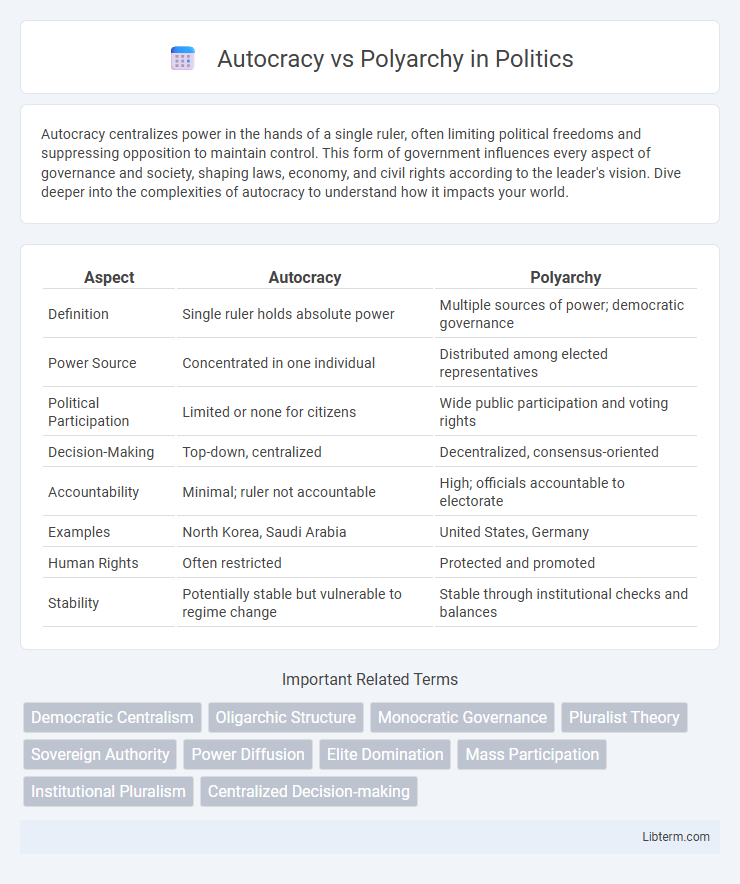Autocracy centralizes power in the hands of a single ruler, often limiting political freedoms and suppressing opposition to maintain control. This form of government influences every aspect of governance and society, shaping laws, economy, and civil rights according to the leader's vision. Dive deeper into the complexities of autocracy to understand how it impacts your world.
Table of Comparison
| Aspect | Autocracy | Polyarchy |
|---|---|---|
| Definition | Single ruler holds absolute power | Multiple sources of power; democratic governance |
| Power Source | Concentrated in one individual | Distributed among elected representatives |
| Political Participation | Limited or none for citizens | Wide public participation and voting rights |
| Decision-Making | Top-down, centralized | Decentralized, consensus-oriented |
| Accountability | Minimal; ruler not accountable | High; officials accountable to electorate |
| Examples | North Korea, Saudi Arabia | United States, Germany |
| Human Rights | Often restricted | Protected and promoted |
| Stability | Potentially stable but vulnerable to regime change | Stable through institutional checks and balances |
Defining Autocracy and Polyarchy
Autocracy is a system of government where power is concentrated in the hands of a single individual or a small group, often characterized by centralized control and limited political freedoms. Polyarchy refers to a form of governance that features multiple sources of power, competitive elections, and broad participation, enabling diverse groups to influence decision-making. These contrasting structures highlight the spectrum of political authority from absolute rule to inclusive, pluralistic democracy.
Historical Origins of Governance Systems
Autocracy traces its origins to ancient civilizations such as Mesopotamia and Egypt, where centralized power allowed rulers to enforce laws and maintain order through absolute authority. Polyarchy, a concept popularized by political theorist Robert Dahl, evolved from classical ideas of participatory governance seen in ancient Athens and Roman republics, emphasizing pluralism and competitive elections. These governance systems reflect contrasting historical responses to power distribution and citizen inclusion in political decision-making.
Core Characteristics of Autocracy
Autocracy is defined by the concentration of power in a single ruler or a small group, with little to no political pluralism or opposition allowed. Key characteristics include centralized control, limited political freedoms, absence of competitive elections, and lack of checks and balances on authority. Autocratic regimes often rely on coercion, censorship, and a controlled media environment to maintain dominance.
Fundamental Principles of Polyarchy
Polyarchy is characterized by multiple sources of power, including competitive elections, broad participation, and diverse political institutions that ensure accountability and pluralism. It upholds the fundamental principles of political equality, inclusive participation, and government responsiveness to the electorate. The system promotes decentralized authority and protects civil liberties, fostering a democratic environment where power is distributed among various interest groups and leaders.
Leadership Structure and Decision-Making
Autocracy centralizes leadership power in a single authority, allowing for rapid decision-making but limited input from others, often resulting in unilateral policies and restricted political pluralism. Polyarchy distributes leadership across multiple institutions or elected representatives, fostering inclusive participation and deliberation that enhance checks and balances within governance. Decision-making in polyarchies involves consensus-building and negotiation among diverse actors, promoting transparency and accountability compared to the top-down authority prevalent in autocratic systems.
Citizen Participation and Political Rights
Autocracy concentrates power in a single ruler or a small elite, severely limiting citizen participation and political rights such as freedom of speech, assembly, and voting in competitive elections. Polyarchy, characterized by multiple centers of power and democratic institutions, enables broad citizen participation through free elections, political pluralism, and protection of civil liberties. In polyarchies, political rights ensure accountability and responsiveness, contrasting sharply with autocracies where political dissent is often suppressed.
Stability and Responsiveness: Comparative Analysis
Autocracy often ensures political stability through centralized decision-making and limited public dissent, but it struggles with responsiveness to citizens' diverse needs due to restricted participation. Polyarchy promotes responsiveness by enabling multiple interest groups and broader citizen involvement, though this can lead to slower policy implementation and occasional instability due to competing interests. Stability in autocracies derives from concentrated power, whereas polyarchies balance stability with adaptability through institutionalized pluralism.
Economic Impacts of Autocratic vs Polyarchic Systems
Autocratic systems often hinder economic growth due to limited political freedoms, centralized decision-making, and increased corruption risks, which can stifle innovation and efficient resource allocation. Polyarchic systems promote inclusive governance, transparency, and accountability, fostering an environment conducive to entrepreneurship, investment, and sustainable economic development. Empirical studies link polyarchies with higher GDP growth rates and better economic resilience compared to autocracies.
Human Rights and Individual Freedoms
Autocracy concentrates power in the hands of a single ruler or a small elite, often resulting in restricted human rights and limited individual freedoms due to centralized control and lack of political pluralism. Polyarchy, characterized by multiple centers of power and competitive elections, tends to promote human rights and safeguard civil liberties through institutional checks and balances, free expression, and participatory governance. Empirical studies indicate that polyarchic systems correlate with higher levels of press freedom, political participation, and protection of minority rights compared to autocratic regimes.
Contemporary Examples and Global Trends
Contemporary autocracies such as Russia and China exhibit centralized power with limited political pluralism, contrasting sharply with polyarchies like the United States and Germany, where competitive elections and institutional checks prevail. Global trends indicate a rise in hybrid regimes blending authoritarian control with democratic features, challenging traditional classifications. Data from Freedom House reveal a decline in global democratic scores since 2010, highlighting the increasing contest between autocratic consolidation and polyarchic resilience worldwide.
Autocracy Infographic

 libterm.com
libterm.com